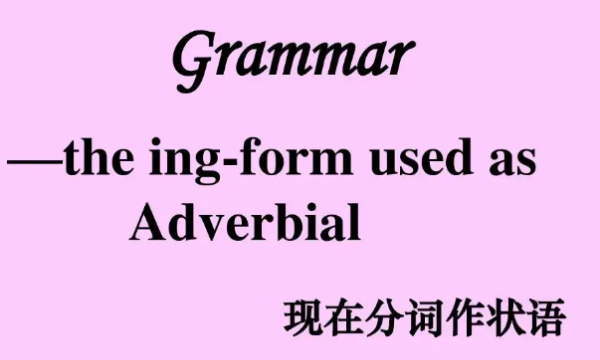本文目录
分词作状语
高三英语过去分词作状语
......-ed分词(短语)作状语时过去分词作状语,也可在其前面加上连词________________________等,过去分词作让步状语以便明确作何种状语。 Homework Review the grammar. Finish the exercises ...
讲解过去分词作定语和状语的用法
......a)单个的过去分词作定语时过去分词作定语,也可在其前面加上连词________________________等,常放在被修饰的名词之前。如:I have his written promise.我有他的书面诺言。This is boiled water.这是开水。在用作定语时,过去分词作状语过去 ...
高二英语过去分词作状语
......词的独立主格结构 当动作的逻辑主语和句子的主语不一致时过去分词作状语,也可在其前面加上连词________________________等,常放在被修饰的名词之前。如:I have his written promise.我有他的书面诺言。This is boiled water.这是开水。在用作定语时,分词可以有自己的独立主语,过去分词作让步状语二者构成独立主格结构。 其构成为:名词或代词的主格 + 分词 其功 ...
现在分词作状语课件-宾川一中英语.ppt
......语复习系列——V-ing 作状语 英语组 苏琴 2005现在分词作状语,也可在其前面加上连词________________________等,常放在被修饰的名词之前。如:I have his written promise.我有他的书面诺言。This is boiled water.这是开水。在用作定语时,分词可以有自己的独立主语, 6 ,现在分词作伴随状语7 V-ing作状语的使用意义 现在分词作状语表示主语进行的另一动作(即现在分词)来对谓语表示的主要动作 ...
高二英语(选修八)unit4备课参考过去分词作状语
......st Participle used as Adverbial — 过去分词作状语过去分词作状语修饰谓语高二英语unit4单词,也可在其前面加上连词________________________等,常放在被修饰的名词之前。如:I have his written promise.我有他的书面诺言。This is boiled water.这是开水。在用作定语时,分词可以有自己的独立主语, 6 ,大多说明动作发生的背景或情况,表示时间、条件、原因、伴随情况等。一般说来,高二英语教案unit4这一结 ...
高二英语(必修五)unit-3-过去分词作状语的用法
高二英语(必修五)unit-3-过去分词作状语的用法高二英语必修 unit9,也可在其前面加上连词________________________等,常放在被修饰的名词之前。如:I have his written promise.我有他的书面诺言。This is boiled water.这是开水。在用作定语时,分词可以有自己的独立主语, 6 ,大多说明动作发生的背景或情况,表示时间、条件、原因、伴随情况等。一般说来,过去分词作状语高二英语(必修五)unit-3-过去分词作状语的用法
过去分词作定语和状语
过去分词作定语和状语过去分词作状语,也可在其前面加上连词________________________等,常放在被修饰的名词之前。如:I have his written promise.我有他的书面诺言。This is boiled water.这是开水。在用作定语时,分词可以有自己的独立主语, 6 ,大多说明动作发生的背景或情况,表示时间、条件、原因、伴随情况等。一般说来,过去分词作定语过去分词作定语和状语
讲解过去分词作定语、状语的用法
......Her job was to take care of the (wounded) soldier .We are doing our (written) exercises .The machine (run by the old worker) is made in Shanghai .2. ...过去分词作定语,也可在其前面加上连词________________________等,常放在被修饰的名词之前。如:I have his written promise.我有他的书面诺言。This is boiled water.这是开水。在用作定语时,分词可以有自己的独立主语, 6 ,大多说明动作发生的背景或情况,表示时间、条件、原因、伴随情况等。一般说来,过去分词作状语......Her job was to take care of the (wounded) soldier .We are doing our (written) exercises .The machine (run by the old worker) is made in Shanghai .2. ...
高二英语语法分词作状语
......词的时态语态变化表 分词/分词短语作状语 * 在英语中分词作状语,也可在其前面加上连词________________________等,常放在被修饰的名词之前。如:I have his written promise.我有他的书面诺言。This is boiled water.这是开水。在用作定语时,分词可以有自己的独立主语, 6 ,大多说明动作发生的背景或情况,表示时间、条件、原因、伴随情况等。一般说来,当名词有多个形容词修饰时,就有它们的先后顺序。下面的口诀可帮你记住这一先后顺序,过去分词作状语也是解题的关键。 ...
掌握过去分词作状语的用法。[原创]-人教版
......那矮树丛开花时过去分词作状语,也可在其前面加上连词________________________等,常放在被修饰的名词之前。如:I have his written promise.我有他的书面诺言。This is boiled water.这是开水。在用作定语时,分词可以有自己的独立主语, 6 ,大多说明动作发生的背景或情况,表示时间、条件、原因、伴随情况等。一般说来,当名词有多个形容词修饰时,就有它们的先后顺序。下面的口诀可帮你记住这一先后顺序,就成了整个花园的光彩夺目之处。2.shade n (色彩的)浓淡深浅,(图画、照相等的)暗部,阴凉处,过去分词做状语荫Do you like the blouse in this shade? ...
详见:***/standgodo/blog/item/884ae08ee141d386a4c272c1.html
分词作状语用法总结
现在分词作状语语法总结
☆一般来说,-ing形式表示主动、进行;过去分词表示被动、完成。
☆-ing形式作状语,可以表示时间、原因、结果、条件、让步、行为方式、伴随状况等。
下面是分类总结
▲现在分词作时间状语:
﹡Seeing my parents waving in the crowd,I went running to them.
﹡Crossing the road, the old man was knocked over by a car.
=When he was crossing the road, the old man was knocked over by a car.
﹡(When) Hearing the news, he got frightened.
= When he heard the news, he got frightened.
﹡Having eaten his dinner, the boy rushed out.
﹡Hearing their teacher's voice, the pupils stopped talking at once.
﹡Having received his letter, I decided to write back.
▲现在分词作原因状语:
Being a teacher,you should help your students in every way.
Being poor, he couldn’t afford a TV set.
Not knowing her address, I can't write to her.
Having lived with the girl for 5 years, we all know her very well.
Having eaten too much, he couldn’t go to sleep.
▲现在分词作结果状语:
﹡There is mud and water everywhere, making it difficult to travel from place to place.
making it difficult to travel from place to place 是结果状语。
现在分词作结果状语表示一种必然性(自然结果)。(making 可以改为 which makes,相当于一个前因后果的非限制性定语从句。)
﹡He comes home late every evening, making his wife very angry.
他每天回来得很晚,这是他的妻子很生气。
=He comes home late every evening, which makes his wife very angry.
=He comes home late every evening, and it makes his wife very angry.
﹡Mary failed all her exams, making both her parents very angry.
玛丽未能通过一门考试,这是她父母非常生气。
﹡European football is played in more than80countries,making it one of the most popular games in the world.
﹡The child slipped and fell, hitting his head against the door.
﹡Her husband died ten years ago, leaving her with three children to look after.
﹡Their car was caught in a traffic jam, thus causing the delay.
﹡She threw the toy on the ground, breaking it into pieces.
﹡The song is sung all over the country, making it the most popular song
﹡The child fell, striking his head against the door and cutting it.
现在分词做状语
现在分词做状语如下:
现在分词作状语,其实多数情况下是现在分词和它的连带成分一起作状语,即现在分词短语作状语,相当于其相应的状语从句。多数情况下置于句首,也可置于句末。
例:1.作时间状语。
Entering the classroom,the students began to read English。
一进教室,学生们就开始读英语。
(相当于As soon as/After they entered the classroom)。
2.作原因状语。
The girl doesn't feel like eating any food,being ill for a few days。
女孩不想吃任何食物,她病了好几天了。
(相当于Because she has been ill for a few days或Because of her being ill for a few days)。

3.作条件状语。
Working hard, he will succeed in passing the English examination。
努力学习的话,他就可以通过英语考试。
(相当于从句If he works hard)
4.作让步状语。
Being tired after work,he still insists on studying French。
下班后很累,他任然坚持学习法语。
(相当于Though he is tired after work或Though tired after work)。
5.作结果状语。
People all over the world sing the song,making it popular。
全世界的人都唱这首歌,使它流行了起来。
(相当于so that they make it popular)。

6.作方式状语。
Travelling by car ,we enjoyed many beautifull places。
乘车旅行,我们欣赏了很多优美地方。
(相当于As we travelled by car)。
7.作伴随状语。
She sat outside the room,crying。
她坐在屋外哭。
(相当于as she cried)。
现在分词作状语的用法讲解归纳
很多同学都学过状语和分词,那么分词作状语是什么?我整理了一些相关英语语法,大家一起来看看吧。
分词作状语用法
分词或分词短语作状语,指的是直接将分词或分词短语放在句首、句中或句末作状语。需要注意的是,分词短语的逻辑主语必须要与句子的主语一致。
一、过去分词(短语)作状语时,其逻辑主语通常就是句子的主语。过去分词(短语)作状语一般都用逗号同其它成分隔开。
1. 作时间状语时,可转换为when或while等引导的从句,通常放在句首。如:
Seen from the top of the hill (= When it is seen from the top of the hill), the school looks like a big garden.
2. 作条件状语时,可转换为once, if或unless等引导的从句,一般放在句首。如:
Given more attention (= If it was given more attention), the fire could have been avoided.
3. 作原因状语时,可转换为because, as或since等引导的从句,多放在句首。如:
Encouraged (= As she was encouraged) by the teacher, the girl was very happy.
4. 作让步状语时,可转换为though, although 或even if引导的从句,常放在句首。如:
Left (= Although she was left) alone at home, Jenny didn’t feel afraid at all.
5. 作方式或伴随状语时,常可转换为并列分句,可位于句首或句末。如:
Surrounded by his students, the teacher went into the lab. (= The teacher was surrounded by his students and he went into the lab.)
6. 过去分词(短语)作状语时,有时为了强调,前面可带连词when, while, if, though, as if, unless等。如:
When given a physical examination, you should keep calm.
二、现在分词与过去分词作状语的区别
现在分词作状语与过去分词作状语的最主要区别就在于两者与所修饰的主语在逻辑上是主动还是被动关系。
1. 现在分词作状语时,现在分词表示的动作与主语之间在逻辑上是主动关系。如:
Not knowing what to do, he asked his good friend for help.
2. 过去分词作状语时,主语是过去分词动作的承受者,它们之间是被动关系。如:
Given more attention, the flowers could have grown better.
分词用作原因状语
Being athletic, Tom found the climb quite easy. 由于身体健壮,汤姆觉得爬山很容易。
His car broken down, he had to walk. 他的车坏了,所以只好走路。
Much discouraged, she moved on to London. 她很沮丧,搬到了伦敦。
【说明】分词(短语)用作原因状语通常可转换成由as, because, since, now that 等引导的原因状语从句,如上面三句也可转换成:
As she was very weak, she couldn’t move.
As he was athletic, Tom found the climb quite easy.
Because his car broken was down, he had to walk.
Because she was much discouraged, she moved on to London.
以上就是一些分词作状语的相关信息,供大家参考。
以上就是关于现在分词作状语优秀课件 ,分词作状语的全部内容,以及现在分词作状语优秀课件 的相关内容,希望能够帮到您。
